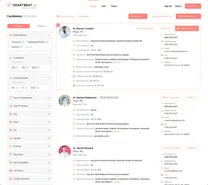Do you know that well-structured marketing strategies have propelled the growth of medical device markets by significant percentages, often ranging from 5% to 15% annually? But why is a precise marketing plan important for medical devices?
The right marketing plan is important for standing out in this competitive field. It’s not enough to simply showcase your product; you need to connect with your audience, understand
In this guide, we’ll look into the key steps that form the backbone of a successful medical device marketing plan. From identifying your audience to crafting compelling messages and choosing the right channels, we cover all the essentials.
So, keep reading till the end to ensure your marketing plan isn’t just good, but great!
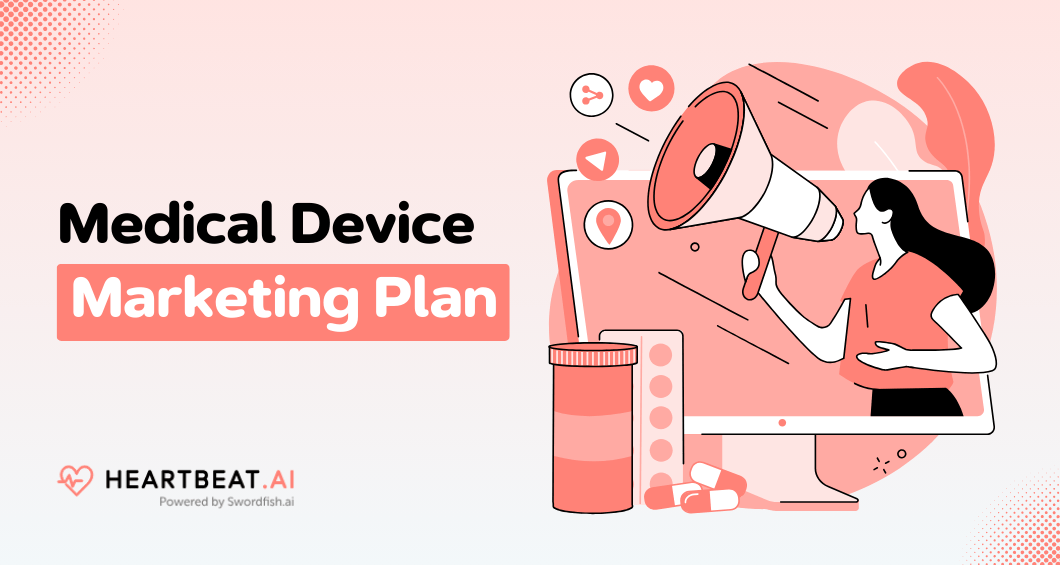
What’s on this page:
What is a Medical Device Marketing Plan?
A medical device marketing plan is a comprehensive document that outlines strategies and actions for promoting and selling medical devices within specific markets. It includes market analysis, audience targeting, competition, regulations, product positioning, promotion, sales channels, and objectives.
Studies show that medical devices accompanied by a strong marketing plan have a significantly higher chance of achieving market success.
Research underscores the importance of strong marketing for medical device success, emphasizing that educational content can make consumers 131% more likely to purchase immediately.
This underscores the importance of creating a product that meets a market need. Additionally, it emphasizes the significance of effectively communicating its value and ensuring it reaches the intended audience.
What is the Importance of a Marketing Plan for Medical Devices?
The importance of a marketing plan for medical devices cannot be overstated. It is important for launching, promoting, and selling medical devices effectively. Here are the key points highlighting its significance:
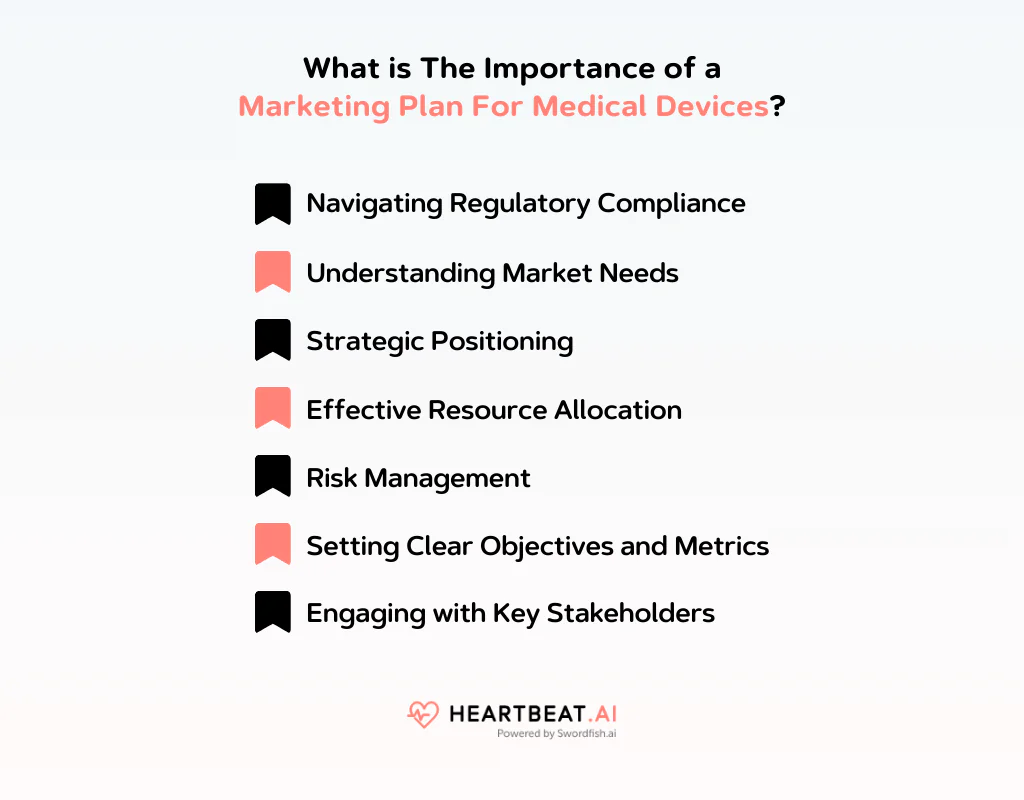
Navigating Regulatory Compliance
A marketing plan helps ensure that all promotional activities are compliant with the regulations set forth by bodies like the FDA and the EMA. This includes adherence to advertising standards, product labeling, and post-market surveillance requirements.
Understanding Market Needs
A well-researched marketing plan allows manufacturers to deeply understand the needs of their target market, including patients, healthcare providers, and other stakeholders. This insight is crucial for developing devices that meet specific medical needs, ensuring that the product effectively addresses the market demand.
Strategic Positioning
The medical device market is crowded with competitors. A marketing plan helps identify a unique value proposition and position the device in a way that differentiates it from others. This could be through innovative technology, superior efficacy, cost-effectiveness, or other factors that make the device stand out.
Effective Resource Allocation
Marketing medical devices require significant investment. A detailed marketing plan ensures that resources are allocated efficiently, focusing on strategies and channels that offer the highest return on investment (ROI).
Risk Management
By identifying potential market risks and barriers to entry, a marketing plan enables companies to develop strategies to mitigate these risks. This could include addressing regulatory challenges, responding to competitive pressures, or overcoming market access barriers.
Setting Clear Objectives and Metrics
A marketing plan outlines clear, measurable objectives for what the company aims to achieve with its medical device. These metrics are essential for monitoring performance, making adjustments, and measuring success over time.
Engaging with Key Stakeholders
Marketing plans outline strategies for engaging with key stakeholders, including healthcare professionals, distributors, and regulatory agencies. Building strong relationships with these stakeholders is crucial for the successful adoption and recommendation of the device.
How to Create Medical Device Marketing Plan
Creating a medical device marketing plan involves a thoughtful approach that aligns your product’s unique benefits with the needs of your target market. Here’s how to structure your plan for maximum impact:
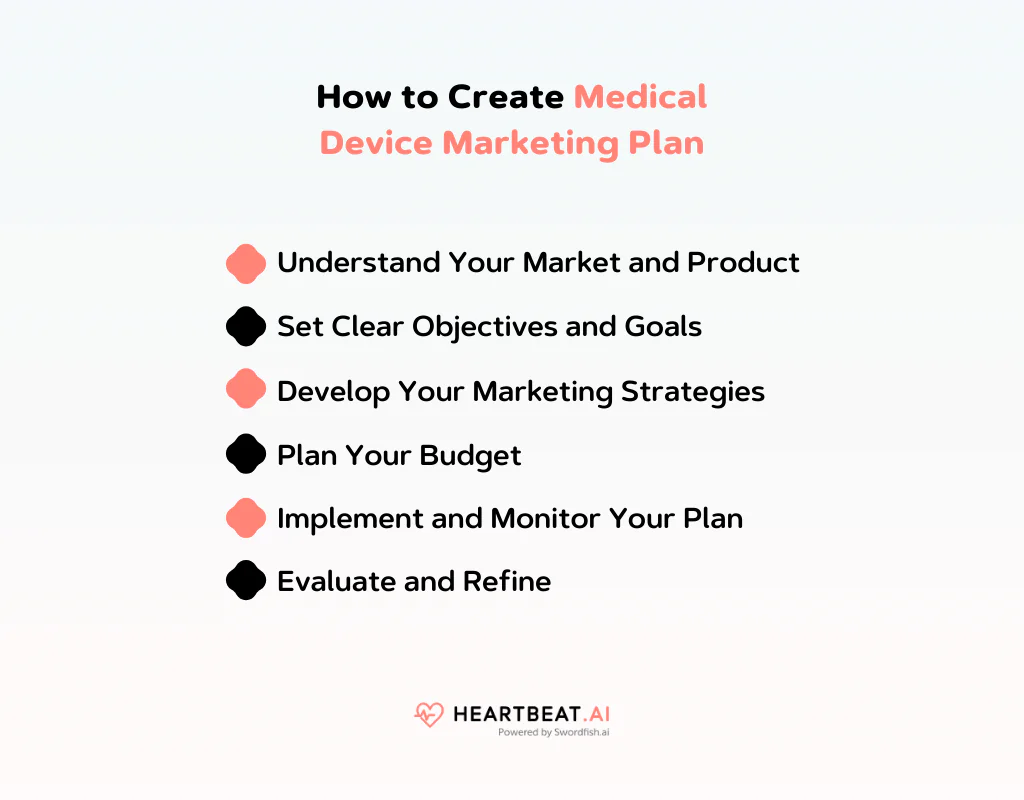
Understand Your Market and Product
Begin by conducting a comprehensive market analysis. Identify your target customers, their needs, and how your medical device addresses those needs. Analyze market size, growth prospects, and trends.
Also, evaluate your competitors to understand their offerings and identify opportunities for differentiation.
Define what sets your medical device apart. Your value proposition should clearly communicate your product’s unique benefits and advantages.
Set Clear Objectives and Goals
Formulate specific, measurable, achievable, relevant, and time-bound marketing objectives. These might range from increasing brand awareness to driving sales over a certain period.
Determine the key performance indicators (KPIs) that will help you measure the success of your marketing efforts, such as website traffic, conversion rates, and sales figures.
Develop Your Marketing Strategies
Segment your target market to tailor your marketing strategies effectively. Recognizing that different groups may respond differently to your messaging allows for more personalized and effective marketing efforts.
Select the most appropriate marketing channels based on where your target audience is most engaged. Options may include digital marketing, trade shows, direct sales, or strategic partnerships.
Implement a content marketing strategy to educate and inform your target audience about your device’s benefits. Use various formats like blog posts, white papers, case studies, and videos to showcase your product’s features and advantages.
Plan Your Budget
Allocate your marketing budget carefully, considering the expected return on investment (ROI) from different channels and activities.
Implement and Monitor Your Plan
Launch your marketing campaigns as planned, ensuring consistency in messaging and alignment with your brand’s voice and value proposition.
Regularly review your KPIs to gauge the effectiveness of your marketing strategies. Be flexible and ready to adjust your plan based on the outcomes.
Evaluate and Refine
After executing your marketing plan, analyze the data to understand the most effective strategies.
Use these insights to refine your marketing approach, potentially reallocating resources to more effective channels, tweaking your messaging, or targeting different segments.
What are the Effective Marketing Channels for Medical Devices?
When marketing medical devices, it’s important to choose channels that not only reach the right people but also follow industry rules. Here’s how you can make the most of different marketing strategies:
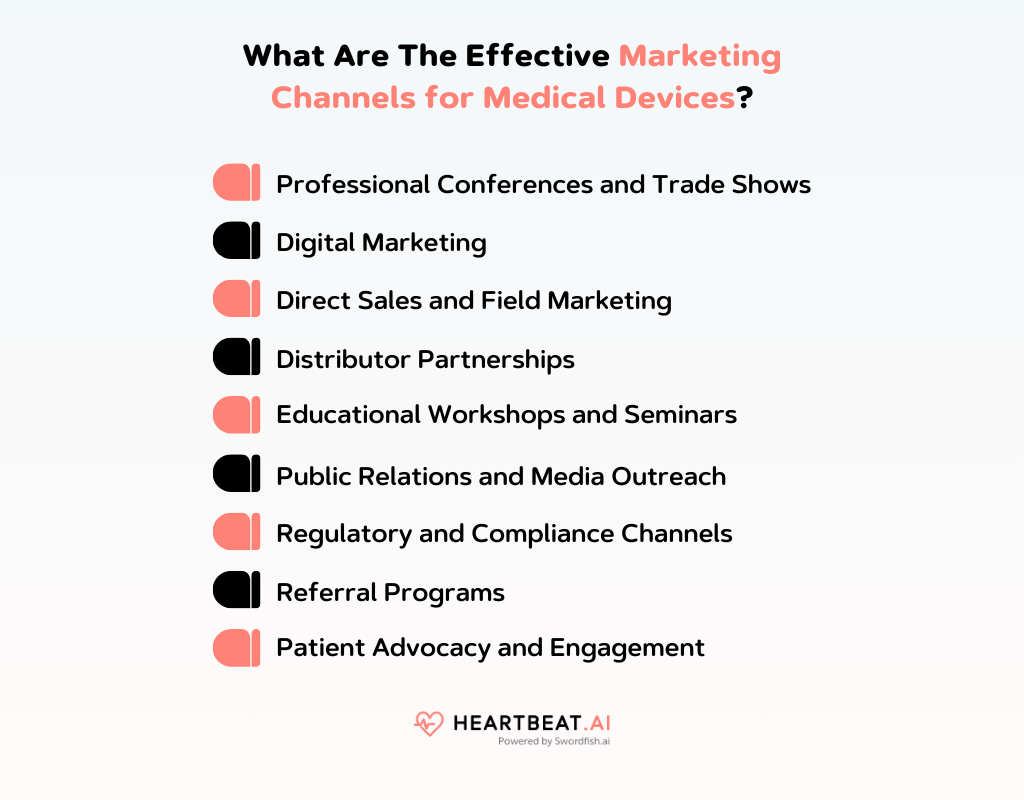
Professional Conferences and Trade Shows
These are fantastic opportunities to get your medical devices in front of the right people. They’re packed with healthcare professionals, industry insiders, and potential investors who are all interested in what’s new and effective.
It’s a chance to demonstrate your product’s unique benefits and network with key stakeholders in person.
Digital Marketing
Effective digital marketing strategies are crucial for medical device companies. You can use websites, blogs, and social media to show or discuss your medical devices.
- Website and SEO: Your website is often the first point of contact with potential customers, so make sure it’s informative and easy to navigate. An optimized site helps you rank higher in search results, making it easier for your audience to find you.
- Content Marketing: Sharing expert articles, insightful whitepapers, or engaging case studies can establish your brand as a leader in the medical device field. This content not only educates your audience but also builds trust in your brand.
- Social Media: Use social platforms like LinkedIn, Twitter, etc to reach directly to healthcare professionals. It’s a good way to keep them updated and engaged.
- Email Marketing: Sending emails is a great way to keep in touch with your audience. You can inform them about new products, special events, or the latest news in your industry.
Direct Sales and Field Marketing
Having a team that can go out and talk to healthcare providers face-to-face is invaluable. Showing how your devices work in person at hospital demonstrations and training sessions can convince them.
Distributor Partnerships
Partnering with established distributors can amplify your reach without the need to build your own network from scratch. These partners come with built-in relationships and market knowledge that can be invaluable in expanding your presence
Educational Workshops and Seminars
By providing valuable educational content, you position your brand as a trusted source of information. These events are perfect for delving deeper into the advantages of your products and how they can solve common challenges faced by healthcare providers.
Public Relations and Media Outreach
Positive media coverage can significantly enhance your brand’s visibility and credibility. Building relationships with journalists and industry influencers can lead to valuable exposure in trusted publications.
Regulatory and Compliance Channels
Understanding and exploring the regulatory requirements is important. Staying engaged with regulatory bodies and ensuring all marketing materials are compliant protects your company and reassures your customers.
Referral Programs
Encouraging referrals from satisfied customers and key opinion leaders in the healthcare industry can be a powerful way to gain credibility and attract new business.
Patient Advocacy and Engagement
Partnering with patient advocacy groups and showcasing patient success stories can humanize your brand. It highlights the real-world impact of your devices, making your marketing messages more relatable and powerful.
Medical Device Marketing Plan Template
Creating a comprehensive marketing plan is essential for the success of any medical device. Here’s a template that can be adapted to your specific needs. This template includes key sections that are crucial for a medical device marketing plan:
Executive Summary
- Overview: Briefly describe the medical device, the target market, and the main objectives of the marketing plan.
- Key Goals: Highlight the primary goals for the upcoming period, such as market penetration rates, revenue targets, and any other critical success metrics.
Market Analysis
- Industry Overview: Provide an overview of the medical device industry, including size, growth trends, and technological advancements.
- Target Market: Define the specific segments of the market that the device is aimed at. Include demographic, geographic, and psychographic details of the target audience.
- Competitive Analysis: Identify major competitors in the space, analyzing their strengths, weaknesses, market position, and product offerings.
Product Overview
- Device Description: Offer a detailed description of the medical device, including its features, benefits, and any unique selling propositions.
- Regulatory Compliance: Outline the regulatory approvals the device has received or is in the process of obtaining.
Marketing and Sales Strategy
- Positioning and Branding: Describe how the medical device will be positioned in the market and the branding strategy that will be employed.
- Pricing Strategy: Detail the pricing model for the device, including any tiered pricing, discounts, or financing options.
- Sales Channels: Identify the primary sales channels through which the device will be sold, such as direct sales to hospitals, through distributors, or online to end-users.
- Marketing Mix (4Ps): Outline the product, price, place, and promotion strategies to be used.
- Product: Emphasize the unique features and benefits of the device.
- Price: Justify the pricing strategy based on value proposition and competitive positioning.
- Place: Detail the distribution channels and logistics.
- Promotion: Outline the promotional activities, including advertising, trade shows, online marketing, and sales promotions.
Operational Plan
- Production: Outline the manufacturing process or partnerships and any scalability plans.
- Supply Chain: Describe the supply chain strategy to ensure timely delivery of the device to the market.
Financial Projections
- Budget: Present a detailed budget covering marketing, sales, production, and operational expenses.
- Sales Forecast: Provide sales forecasts for the device, including best-case and worst-case scenarios.
Metrics and Evaluation
- Performance Metrics: Define the key performance indicators (KPIs) that will be used to measure the success of the marketing plan.
- Evaluation and Adjustment: Describe the process for regularly reviewing the plan’s performance and making necessary adjustments.
Appendices
- Supporting Documents: Include any additional information, such as market research data, product specifications, or detailed financial models.
Advantages of Medical Device Marketing Plan Template
Utilizing a template can offer several advantages, ensuring a comprehensive and strategic approach to marketing your medical device. Here’s a closer look at these benefits:

Structured Approach
A template guides the creation of a marketing plan, covering market analysis, target audience, competition, strategies, budgeting, and performance metrics comprehensively. This organized approach simplifies the planning process, enhancing efficiency and coherence in strategy development.
Time and Resource Efficiency
Developing a marketing plan from scratch can be time-consuming and resource-intensive. A template simplifies this process by providing a predefined framework that you can customize according to your specific needs. This efficiency allows you to focus more on strategy and less on format, speeding up the time to market.
Consistency and Clarity
Using a template ensures consistency across your marketing plan, making it easier for team members, stakeholders, and potential investors to understand your marketing strategy. A consistent format improves readability and comprehension, facilitating better communication and alignment within your organization.
Best Practices Incorporation
Templates are often designed based on best practices and successful strategies from within the industry. By using a template, you can benefit from the knowledge and experience of marketing professionals and industry experts, incorporating proven strategies into your plan.
Customization and Flexibility
While a template provides a basic structure, it also offers the flexibility to customize and adapt to your unique product and market situation. You can add or remove sections, adjust the level of detail, and tailor the content to best suit your medical device and target audience.
Risk Mitigation
A comprehensive marketing plan template helps in identifying potential risks and challenges in the market. By addressing these issues early, you can develop strategies to reduce risks, such as regulatory hurdles, competitive pressures, or market entry barriers.
Performance Tracking and Measurement
Templates often include sections for defining key performance indicators (KPIs) and metrics for success. This focus on measurement allows you to set clear objectives, track progress, and make data-driven decisions to optimize your marketing efforts over time.
What are the Challenges in Medical Device Marketing?
Marketing medical devices presents a unique set of challenges that companies must navigate to successfully introduce and sustain their products in the healthcare market. Here are the key challenges in medical device marketing:
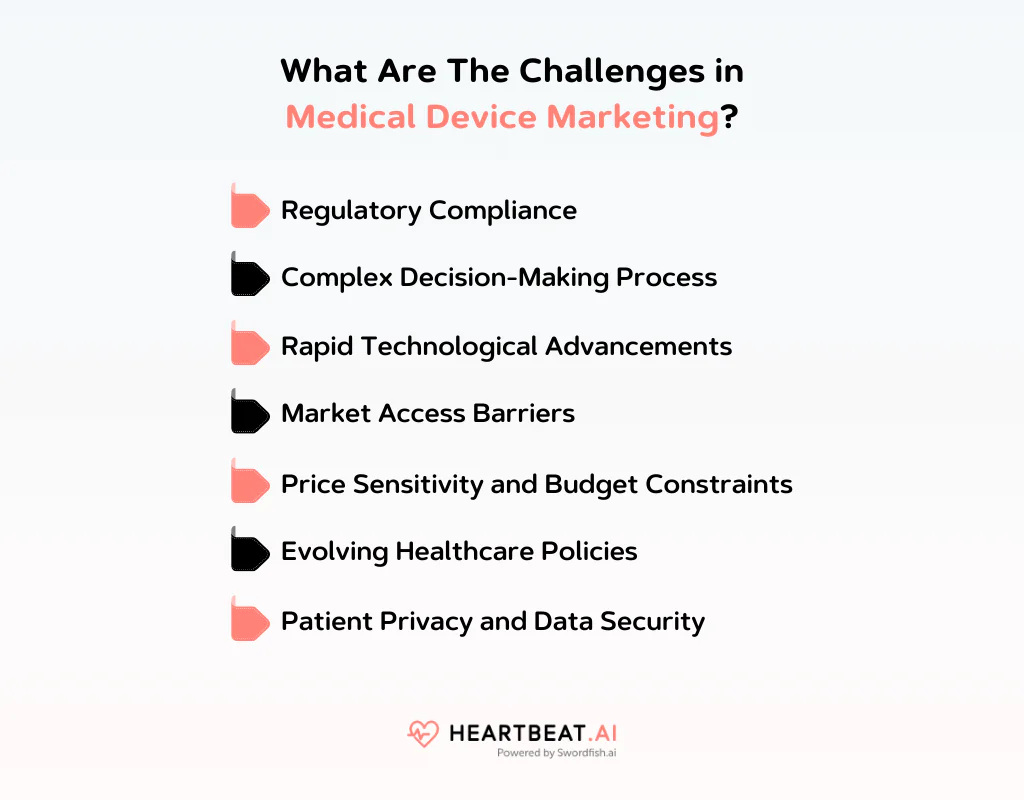
Regulatory Compliance
A major challenge is complying with strict regulatory standards like the FDA and EMA regulations. These regulations govern not only the development and approval of medical devices but also how they are marketed. Ensuring compliance while effectively communicating the value and benefits of a device requires careful planning and expertise.
Complex Decision-Making Process
The decision-making process in purchasing medical devices is complex, involving multiple stakeholders, including physicians, hospital administrators, procurement teams, and sometimes patients. Each group has its own set of concerns and priorities, making it challenging to create marketing messages that resonate with all parties involved.
Rapid Technological Advancements
The fast pace of technological innovation in healthcare means that medical devices can quickly become outdated. Keeping up with the latest advancements and ensuring your product remains relevant and competitive is a constant challenge.
Market Access Barriers
Gaining access to healthcare markets can be difficult due to regulatory hurdles, patent issues, and the need for extensive clinical trials. These barriers can delay the launch of new devices and increase the cost of market entry.
Price Sensitivity and Budget Constraints
Healthcare providers and patients are increasingly sensitive to the cost of medical care, including devices. Budget constraints, especially in public healthcare systems, can limit your target market and necessitate a focus on cost-effectiveness and value in your marketing messages.
Evolving Healthcare Policies
Changes in healthcare policy, insurance coverage, and reimbursement rates can have a significant impact on the demand for medical devices. Keeping abreast of these changes and adapting marketing strategies accordingly is a continual challenge.
Patient Privacy and Data Security
With the increasing use of digital health technologies and connected devices, protecting patient privacy and ensuring data security is paramount. Marketing strategies must address these concerns and demonstrate compliance with data protection regulations.
Find the Right Healthcare Professionals for Medical Device Marketing
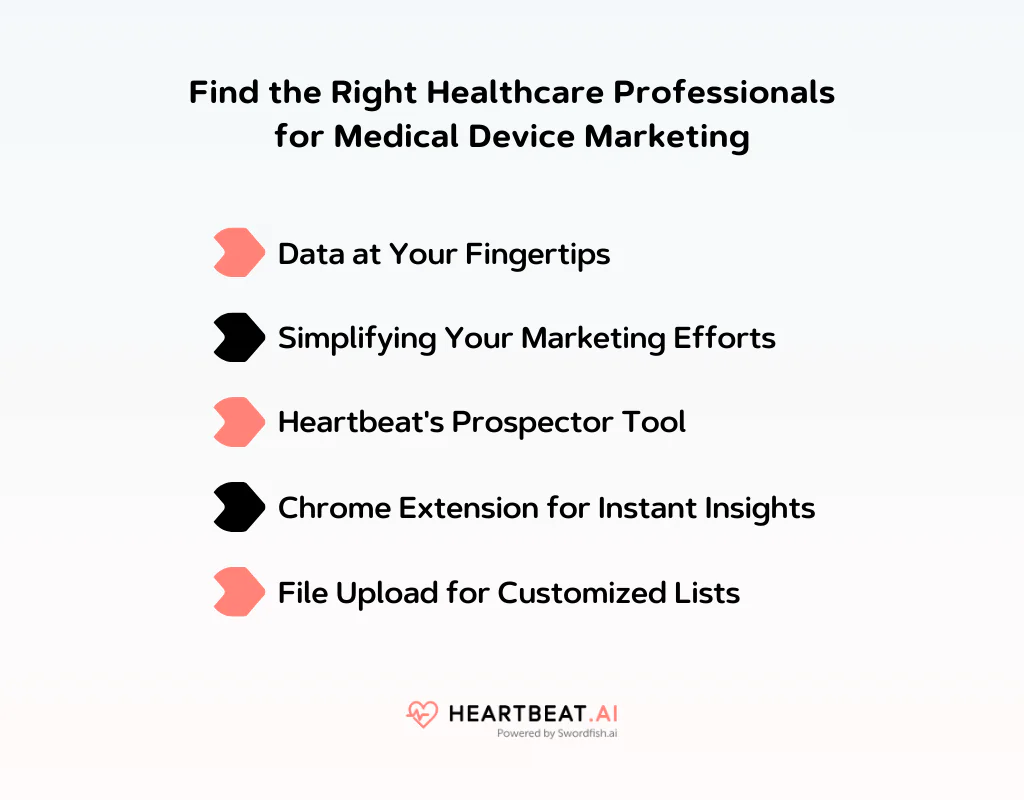
Marketing medical devices requires targeting the right healthcare professionals. Heartbeat AI is a trusted tool that simplifies this by connecting you with relevant individuals. Here’s how it can help a medical device marketing agency:
Data at Your Fingertips
With Heartbeat AI, you get access to data on 11+ millions of healthcare professionals globally, spanning various specialties. We continuously update the vast database that enables precise targeting, facilitating tailored marketing campaigns that resonate with potential medical device users.
Simplifying Your Marketing Efforts
Heartbeat AI is designed to simplify your marketing efforts, making it simpler and more efficient to reach your target audience. By automating the process of data analysis and audience segmentation, it frees up your time to focus on crafting compelling messages.
Heartbeat’s Prospector Tool
The Prospector tool helps pinpoint potential medical device users by analyzing extensive healthcare data. It identifies professionals based on specialties, interests, and tech engagement, aiding the efficient targeting of cardiologists, orthopedic surgeons, and other specialists.
Chrome Extension for Instant Insights
Heartbeat’s Chrome Extension provides instant insights into healthcare professionals’ profiles as you browse online. We offer details on their interests, specialties, and alignment with your medical device, aiding quick decision-making and improving targeting strategy efficiency.
File Upload for Customized Lists
Heartbeat AI’s file upload feature enriches existing contacts with updated data on specialties and recent publications. This enables customized marketing approaches tailored to each healthcare professional’s current interests and needs.
Conclusion
So far, we’ve explored the ins and outs of the medical device marketing plan, covering strategies that are more than just theories. These are tried and tested methods guaranteed to bring about the best outcomes.
Numerous medical device marketing strategy pdf are available online, offering a wealth of knowledge and insights. Exploring these resources can provide valuable strategies and best practices customized to the medical device industry.
We encourage you to put these strategies into practice and witness the growth in your medical device business firsthand. So, give it a try and see the results for yourself!
Frequently Asked Question
Why is market analysis important for a medical device marketing plan?
Market analysis is crucial because it provides insights into the competitive landscape, identifies target market segments, and assesses customer needs. This information helps in customizing marketing strategies to meet the specific demands of the market effectively.
What regulations should be considered in a medical device marketing plan?
Regulations include compliance with the Food and Drug Administration (FDA) in the U.S., the European Union’s Medical Device Regulation (MDR), and other regional regulatory bodies. Marketing materials and claims must also comply with these regulations to ensure they are accurate and not misleading.
What pricing strategies are effective for medical devices?
Effective pricing strategies may include cost-plus pricing, value-based pricing, competitive pricing, or tiered pricing. The choice depends on the device’s cost of production, perceived value to the customer, competitor pricing, and overall market demand.

